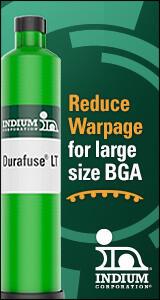|

|
|
| Ask the Experts | |||||||
|
|||||||
|
April 21, 2008 - Updated April 21, 2008 - Originally Posted Requirements for 01-005 assemblyAre there any specific requirements and preparation to consider for 01-005 component assembly process? Please include printing and thermal requirements if known? S. O. |
|||||||
| Expert Panel Responses | |||||||
|
From the placement side, you need a machine with high accuracy, an accurate feeder design, and a precision 01005 nozzle. We at Juki have placed millions of 01005's in the past 2 years, and we have found that screen printing is the most critical step in the process. If the printing is good, the placement process is rather routine. As we demonstrated live at APEX, printing, placing and reflowing 01005's is so routine, we built 100's of boards in our booth during the show and passed them out to visitors.
North America Sales Manager Essegi Automation Mr. Black was the President and Co-Founder of Zevatech in 1977 and introduced first Pick and Place System at Nepcon West 1980. Bob is now the President, CEO and Co-Founder of Juki Automation Systems. He is also a Co-Founder of the SMEMA Council of IPC. He serves as a member of SMTA and SEMI..
01005 is not a dramatic departure but there are some basic guidelines that can be helpful:
President Heller Industries Inc. Mr. Peo has been with Heller Industries for over 20 years and has been President for the past 8 years. Marc has authored several industry articles on Soldering, Flux collection, nitrogen use and Lead Free conversion.
|
|||||||
| Submit A Comment | |||||||
|
Comments are reviewed prior to posting. You must include your full name to have your comments posted. We will not post your email address. |
|
Free Newsletter Subscription
Circuitnet is built for professionals who bear the responsibility of looking ahead, imagining the future, and preparing for it. Insert Your Email Address |
|

|




